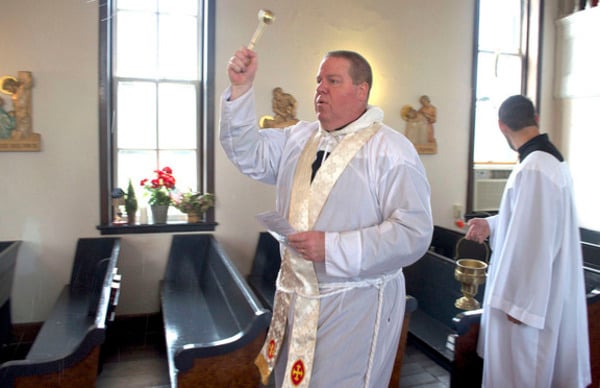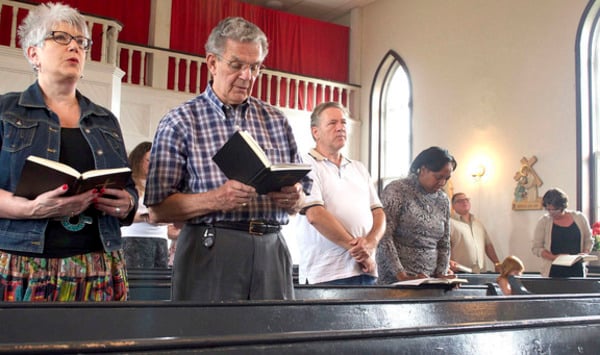Worshipers take unorthodox turn to Orthodoxy

Father James Hamrick sprinkles holy water as he walks amid the pews at St. John the Baptist Orthodox Church. David Frey photo.

Congregants take part in Sunday Mass at St. John the Baptist Orthodox Church. Church goers say they were drawn to the tiny church in part for its ancient rituals and traditions. David Frey photo.
David Frey – 14/7/13
LEWISTOWN — In an old red brick church down a winding road, Gregorian chants and incense rise up to the bell tower.
“Kyrie eleison,” the congregants intone, while at the altar, a retired cop-turned-Orthodox priest performs rituals as old as Christianity. When he steps down to face the crowd, he delivers a sermon like a country preacher, sweat beading on his forehead.
“Some of us here are former Methodists,” says the Rev. James Hamrick, wearing white vestments over a black cassock, addressing two-dozen worshippers scattered sparsely through the pews. “Some of us were former Lutherans. Some of us were former Episcopals. Evangelicals. Non-denominational Christians. Pentecostals. But the one single factor that is common to all of our journeys — no, not where we come from — is that fact that we pursued the truth of God’s self-revelation.”
Saint John the Baptist Orthodox Church is a tiny congregation in a rural corner of Frederick County. Its members number about 50, most of whom left mainline Protestant congregations for what they believe is the closest they can come to the original Christian church.
Traditionally, Orthodox churches in this country filled with immigrants maintaining their religion in their adopted country. But over the past 26 years, the Orthodox Church has swelled with dissatisfied Protestants and Catholics.
Gilbert Kelbaugh, of Frederick, said he found in Orthodoxy the formality he remembered in the Episcopal church of his childhood.
“When I got back from Vietnam, there was not much I recognized,” said Kelbaugh, who said he had given up church for years.
The Orthodox Church remains small in this country. Just 1.5 million Americans are members, about as many as are Muslim. Its ranks are growing, though. Since 2000, the church has seen a 17 percent growth in the number of congregations, according to church statistics. That growth has been driven largely by converts.
In a 2011 survey, fewer than half the Orthodox parishes in the country said they had a strong ethnic heritage. Converts make up more than a quarter of the Greek Orthodox Archdiocese, the largest Orthodox Church in the country, and a majority of the second-largest Orthodox Church, according to a 2008 study. Smaller churches, like the Antiochian Orthodox Christian Archdiocese, with which St. John the Baptist is affiliated, rely on coverts for most of their members and are growing quickly, from 65 parishes in the mid-’60s to more than 250 today.
“People call it the best-kept secret in America,” Hamrick said, “but we’re trying to not keep it a secret anymore.”
The movement got under way in 1987 when more than 200 former Evangelical Protestants joined the Orthodox Church in a mass conversion, led largely by Peter Gillquist, a disenchanted Protestant evangelist-turned-Orthodox priest.
“In an era of increasing radical change, deformation, loss of tradition, tacked-on tradition, I think people are looking for stability, continuity and fidelity,” said the Rev. Alexander Webster, archpriest at St. Herman of Alaska Orthodox Church in Stafford, Va., and the author of several books on Orthodoxy.
Converts sometimes find themselves at odds with ethnic Orthodox practitioners. Many newcomers come from evangelical or conservative Episcopal backgrounds. But a Pew Forum on Religious Life and Society found most Orthodox practitioners support abortion rights and acceptance of homosexuality.
Many also find a sense of ritual and tradition they were longing for.
“There’s not a lot of hand clapping going on in Orthodox circles,” said Webster, a former Catholic. “We’re very solemn. But that’s part of the mysterium tremendum — the awesome history of worship.”
Father Hamrick was the son of a Methodist minister in a family that traced its Methodist heritage back to the 1700s. Hamrick followed in his footsteps, working as both a preacher and a University of Maryland campus cop.
After six years as a Methodist minister, he joined the Charismatic Episcopal Church in search of a more liturgical church and started a congregation in a 130-year-old Methodist chapel set in a cemetery near his hometown of Thurmont. When internal division split the Charismatic Episcopals, Hamrick was drawn to Orthodoxy. Nearly all the congregation agreed to come along, he said, and the church came under the wing of the Antiochians.
Hamrick hung up his collar and brought in a visiting priest until he was ordained into Orthodoxy in 2009.
“There is a blessing that comes in having been accepted into a church that has existed for 2,000 years,” he said.
The ancient rites can be daunting to newcomers. Hamrick’s wife, Pamela, makes a point of helping them through the chants and rituals.
“It’s kind of complicated,” she said.
The faith comes with challenges for many newcomers, especially Protestants who chafe at veneration of the Virgin Mary, prayers to saints and the use of relics. A golden box on the altar of the Lewistown church is said to hold a portion of St. John the Baptist’s finger bone.
“I rebelled against it at first,” said Rick Andersen, who with his wife Kathy drives one and a half hours from New Bloomfield, Pa., for services. Andersen said his faith has ranged from Catholic to Jehovah’s Witness, but he likes the traditions of Orthodoxy.
“This is where we belong,” he said.
Follow David Frey on Twitter @davidmfrey

“But a Pew Forum on Religious Life and Society found most Orthodox
practitioners support abortion rights and acceptance of homosexuality.” Really? Would love to see the source for this.
I do not know any Orthodox who approve abortion and we have a march against it every year!
Orthodoxy will never accept abortion as a form of birth control, nor will it accept homosexuality as a way of life.
668337 778535Howdy! Do you know if they make any plugins to safeguard against hackers? Im kinda paranoid about losing everything Ive worked hard on. Any suggestions? 428946